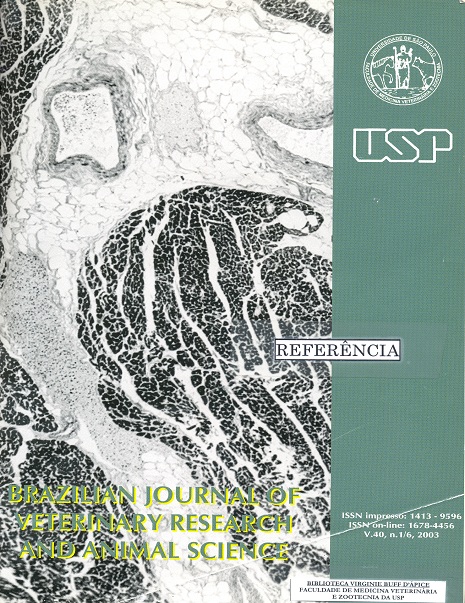Inquiry of cases of myiasis by Dermatobia hominis in dogs (Canis familiaris) of the Northern and Western zones of Rio de Janeiro city in 2000
DOI:
https://doi.org/10.1590/S1413-95962003000100002Keywords:
Dogs, Myiasis, Warble flyAbstract
An inquiry about cases of myiasis by Dermatobia hominis larvae on dogs presented to 190 veterinary establishments of the Northern and Western Zones of Rio de Janeiro City in 2000 was performed. Cases were presented to 37 of 108 establishments in the Northern Zone and to 55 of 82 in the Western Zone of the city. Presence of rural or forest areas and coexistence of dogs and farm animals created an adequate ambient to flies proliferation, including the vector flies of Dermatobia hominis eggs. Adult, pure breed, short and dark-haired dogs were most infested. Males were most infested in the Northern Zone, while in the Western Zone no predilection for sex was noticed. Dogs kept in small farms and house yards, as adult and large breed dogs (usually for house guard), were most affected. Dorsal and lumbar regions, which are easily accessible to flies, were most infested body regions. Prevention programs against myiasis should be intensified during months of highest incidence, although sometimes it is not possible, because many clinicians reported that no month presented higher incidence than another or they did not know to answer this question. Clinicians should warn pet owners that it is necessary to correct handling and to maintain hygiene of the place where the dogs are kept, in order to avoid the existence of flies. More studies are necessary in order to identify other predisposing causes to myiasis and avoid this disease.Downloads
Download data is not yet available.
Downloads
Published
2003-01-01
Issue
Section
UNDEFINIED
License
The journal content is authorized under the Creative Commons BY-NC-SA license (summary of the license: https://
How to Cite
1.
Cramer-Ribeiro BC, Sanavria A, Monteiro HHMS, Oliveira MQ de, Souza FS de. Inquiry of cases of myiasis by Dermatobia hominis in dogs (Canis familiaris) of the Northern and Western zones of Rio de Janeiro city in 2000. Braz. J. Vet. Res. Anim. Sci. [Internet]. 2003 Jan. 1 [cited 2024 Apr. 23];40(1):21-8. Available from: https://www.revistas.usp.br/bjvras/article/view/11386





